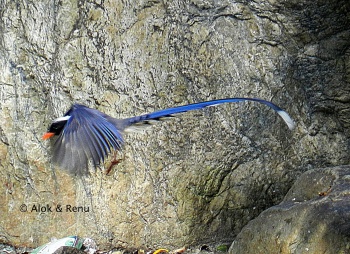Alternative names: Blue Magpie; Red-billed Magpie
- Urocissa erythroryncha
Identification
53 - 64cm (20¾-25 in). A highly distinctive blue magpie with a very long tail:
- Black head, neck and breast
- Blue spotting on crown
- Dull blue shoulders and rump
- Grey-cream underparts (white in some subspecies)
- White tipped brighter blue tail and primaries
- Bright orange-red bill, legs, feet and eye ring
Sexes similar. Juveniles are duller than adults.
Similar species
Gold-billed Magpie is similar, but Blue Magpie is bluer and whiter in appearance, has a red bill and extensive white speckles and spangling over most of crown and nape.

Photo © by Alok Tewari
Almora, Himalayas, Alt.5200 ft., India, 15 October 2016
Distribution
Found in the Himalayas from northwest India to Nepal, Bhutan and east to Burma, Thailand, Cambodia, Laos and Vietnam. Also in south and central China up north to Bejing and Inner Mongolia.
Widespread and locally common.
Taxonomy
Subspecies
There are 5 subspecies[1]:
- U. e. brevivexilla in south-western Manchuria and northern China
- U. e. erythroryncha from central China to southern Yunnan, northern Laos and northern Vietnam
- U. e. alticola in south-western China (northern Yunnan) and north-eastern Myanmar
- U. e. occipitalis in the Himalayas (Punjab to Sikkim)
- U. e. magnirostris from the Hills of Assam (India) to Indochina

Photo © by Alok Tewari
Kainchi Ashram, Dist. Nainital, Uttarakhand Himalayas, Alt. 4500 ft., India, 28 October 2011
Habitat
Evergreen forest and scrub, hilly or mountainous country. Recorded from sea-level up to 2200m. Where ranges meet with Gold-billed Magpie replaced by the latter in higher elevations.
Behaviour
Diet
The diet includes invertebrates, small animals, fruit and seeds. It takes eggs and chicks from nests.
Mostly seen in small family groups. Generally a rather shy bird.
Breeding
Breeding season April to June in India and China. They build a shallow nest in trees or shrubs and 3-5 eggs are laid.
Movements
A resident species with altitudinal movements in the Himalayas.
Vocalisation
Recording © by Alok Tewari
Five types of calls given by two individuals, sitting in a Chir Pine tree, in this early morning recording.
Dwarahat, Alt. 4800 ft., Dist. Almora, Uttarakhand Himalayas, India, Nov.-2016.
References
- Clements, J. F., T. S. Schulenberg, M. J. Iliff, D. Roberson, T. A. Fredericks, B. L. Sullivan, and C. L. Wood. 2017. The eBird/Clements checklist of birds of the world: v2017, with updates to August 2017. Downloaded from http://www.birds.cornell.edu/clementschecklist/download/
- Del Hoyo, J, A Elliott, and D Christie, eds. 2009. Handbook of the Birds of the World. Volume 14: Bush-shrikes to Old World Sparrows. Barcelona: Lynx Edicions. ISBN 978-8496553507
Recommended Citation
- BirdForum Opus contributors. (2024) Red-billed Blue Magpie. In: BirdForum, the forum for wild birds and birding. Retrieved 18 April 2024 from https://www.birdforum.net/opus/Red-billed_Blue_Magpie
External Links




